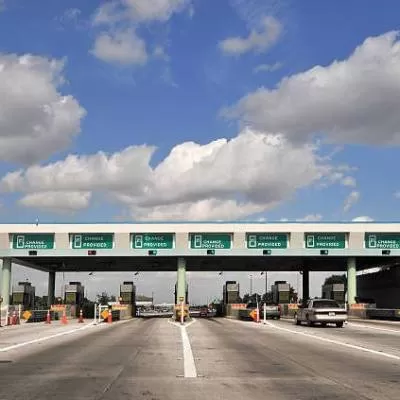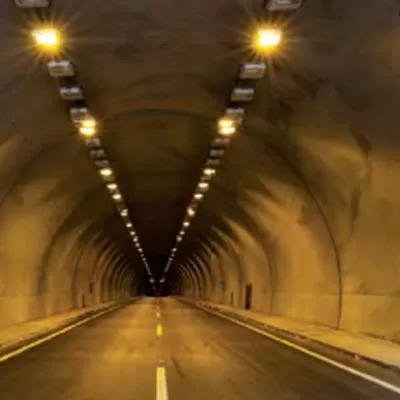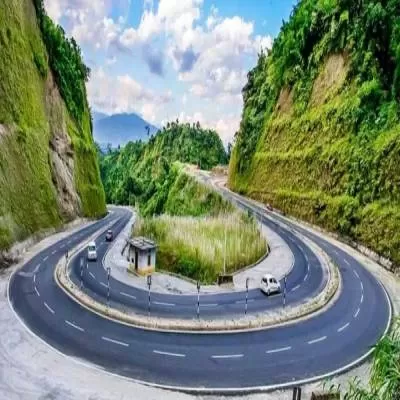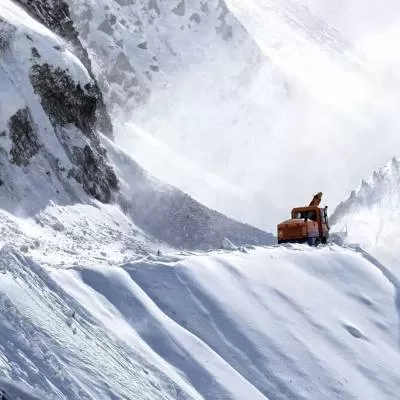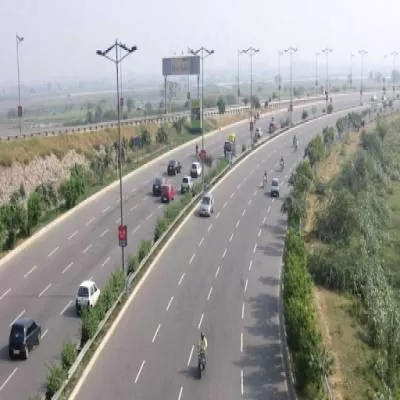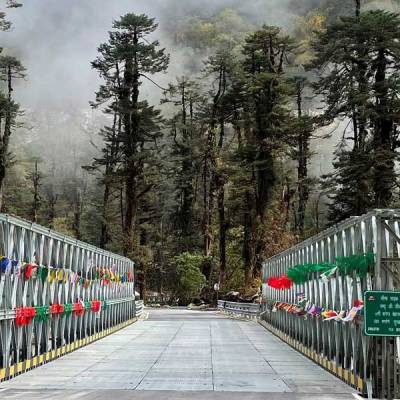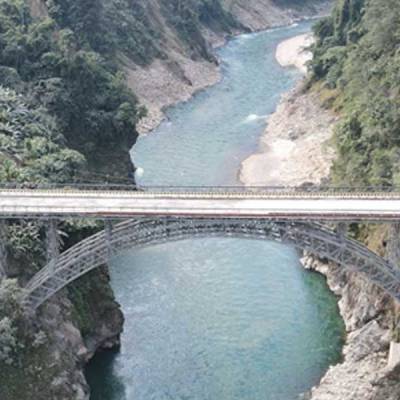- Home
- Infrastructure Transport
- ROADS & HIGHWAYS
- Bridging the Gap
Bridging the Gap
Read full article
CW Gold Benefits
- Weekly Industry Updates
- Industry Feature Stories
- Premium Newsletter Access
- Building Material Prices (weekly) + trends/analysis
- Best Stories from our sister publications - Indian Cement Review, Equipment India, Infrastructure Today
- Sector focused Research Reports
- Sector Wise Updates (infrastructure, cement, equipment & construction) + trend analysis
- Exclusive text & video interviews
- Digital Delivery
- Financial Data for publically listed companies + Analysis
- Preconceptual Projects in the pipeline PAN India
gainst the backdrop of recent bridge collapses, completion of long-awaited bridge landmarks and mega launches, CW explores the innovative methods, materials, equipment and quality standards that can add to building healthy connectivity across the country. Modern major bridges designed and constructed for a service life of 100-120 years; lifespan can be extended if maintained properly.Detailed investigation and preliminary planning should be done by the client or contractor.Availability of mobile bridge inspection units made mandatory by NHAI for better inspections.Emerging trend: Sustainable and environment-friendly materials for concrete production.They say, ‘Don’t learn safety by accident.’ But that seems to be the way we do it in India.Last year, Mumbai witnessed a stampede-like situation near Lower Parel station – which witnesses a footfall of nearly 150,000 every day – as the Western Railway closed the road-over-bridge (RoB), citing an audit report by IIT-B, which deemed the structure unfit owing to corrosion. But there was no concrete dispersal plan for pedestrians and vehicles and no signage or officials to direct the crowd. What’s more, torrential downpour in July 2018 saw the collapse of the Gokhale RoB at Andheri station, which served as a pedestrian-accessible connection between the bustling east and west sides of Andheri. Other mishaps in the financial capital this year include the Mumbai CST foot-over-bridge collapse and the bridge crash at the Vashi Mini Seashore site. Mumbai is not alone – Kolkata and Varanasi, among others, have witnessed similar mishaps. In fact, Kolkata has recorded three major bridge collapses in five years: Ultadanga Flyover (2013), Vivekananda Flyover (2016), and Majerhat Bridge (2018).Systemic failures?Art critic and social thinker once said, “Quality is never an accident. It is always the result of an intelligent effort.” So have we lacked the requisite efforts when it comes to bridges?Challenges in old bridges mostly arise from lack of availability of drawings, deterioration of material properties over time, and increase in loading since the time they were built.According to railway expert Vivek B Sood, “Indian Railways has a comprehensive system of inspections, carried out periodically at different levels, and special checks are done occasionally if warranted.” However, for many bridges, regular checks and retrofitting of existing structures are crucial. “This is an area that cannot be over-emphasised, not just in India but world over,” he adds. “There will always be old bridges. Inspection techniques, retrofitting techniques and health monitoring are important. The concept of load rating also requires a lot of work to ensure bridges give good service.” To keep a regular check on bridges, though, we first need a record of them. Chetan R Raikar, Chairman and Managing Director, Structwel Designers and Consultants, says, “The Central Government is preparing an inventory of the total number of bridges on the National Highways along with condition assessment.” Structwel has been involved in the assessment and testing of bridges for over three decades. As per rough estimates, there could be about 2.5 lakh bridges on the National Highways. Maharashtra itself has over 15,000 state highway bridges. So across 33 states, there could be another 3.5 lakh state highway bridges. Put together, one can roughly consider 6 lakh bridges in the country, along with private bridges like jetties and others. And that is a huge inventory to maintain.Evidently, managing bridges requires a system. “The system should collate all data from various types of bridges and try to assist human inspections with analytics gained from previous inspections and previous history,” suggests Sood. Such a system could identify problems early, with adequate time to address underlying issues.Progress report on bridge constructionThe past decade has witnessed a sea change in the implementation of bridge projects. NN Sinha, Chairman, National Highways Authority of India (NHAI), and Managing Director, National Highways & Infrastructure Development Corporation (NHIDCL), shares an update on recently completed and upcoming bridge projects:Recently, NHAI has completed an eight-lane bridge of about 500 m within a year. Major bridges are coming up over Koshi and Ganga in coming years. For NHIDCL, major forthcoming projects include Asia’s longest bridge between Dhubri (Assam) and Phulbari (Meghalaya) at 20 km; Jogighopa in Assam at 3 km; Gohpur-Numaligarh bridge in Assam at 13 km (over river Brahmaputra); and Mechi Bridge at 1.5 km on the India-Nepal border at Pani Tanki, West Bengal, over river Pheni at Sabroom, Tripura, on the India-Bangladesh border at 1.9 km, and on river Chenab between Jammu and Akhnoor in Jammu & Kashmir. NHIDCL is also exploring the possibility of a bridge between Chatham and Bambooflat in South Andaman Island over the sea. No one could have imagined this in the past. But such news will now be a regular feature, mainly owing to developments in computational facilities, new materials, equipment, etc.Personality:- “The Centre is preparing an inventory of no. of bridges on NHs along with condition assessment.”- Chetan R Raikar, Chairman and Managing Director, Structwel Designers and ConsultantsBridges to successHere’s the good news. Along with the tragedies, bridge success stories have also been making headlines. Many Indians believe one of the first bridges in the world was constructed here: The 50-km Ram Setu. Lore aside, bridge construction has come a long way from the age-old technologies that were being adopted till the mid-1980s. “We have had revolutionary changes in concrete technology,” says Shashikant Limaye, Member Expert Committee, Pune Metro Project. The Konkan Railway Project (1991-97) involved the construction of 250 major bridges along the west coast, most of which were completed within three to four years. The chief engineer (design and coordination) on this project, Limaye shares, “Konkan Railway, for the first time, adopted cast-in-situ bored RC piles for deep foundations and pre-casting of concrete girders in a big way.” Today, these are the norm for speedy and quality construction, whether it is metro viaducts, highway bridges, flyovers or sea-links. Other landmarks include the much awaited Bogibeel road and rail bridge over the Brahmaputra river in Assam (see the CW February edition), and Signature Bridge in Delhi (see page 98), and exciting upcoming projects such as the Mumbai Trans-Harbour Link (MTHL), Mumbai-Nagpur Expressway, Chenab River Railway Bridge, Basohli Cable Stayed Bridge, and others. (See box on ‘Progress report on bridge construction’.) Commenting on the paradigm shift in bridge building, Limaye says, “From 1.2/1.5 m dia piles in Konkan Railway, today, 2.2 m dia piles are being provided on MTHL.”Thus, there are huge opportunities for construction and EPC players in this segment.“Highway construction and expansion in India touched 10,800 km in 2018-19, about 30 km per day,” says Vivek Gautam, COO-Strategic Business Group – Core Infra, Tata Projects. “The Railway Ministry also claims to be laying about 20-23 km of rail tracks every day. This road and rail network expansion will require bridges to connect certain sections to overcome geographical hurdles like hills or rivers.”And RVR Kishore, Project Director, Hindustan Construction Company, points out, “India has achieved only 10 per cent of its current requirement of bridges, with several cities and rivers still required to be bridged. While the road network has improved in the past few years, the focus on bridges –including railway bridges – to improve connectivity needs to be stronger. With this, there will be an increasing requirement for specialised subcontractors as well.”Complexities in bridge constructionThe success of a bridge project depends on the management of various complex and interlinked issues such as timely decisions, robust risk assessment and its mitigation, timely approvals of design and drawings, effective mobilisation of men and machinery, material planning, implementation of right construction methods, project and financial management, prompt and timely troubleshooting, and optimal and effective usage of resources. This plus, there could be more issues that are technical and administrative in nature. SV Desai, Executive Vice President & Head-Heavy Civil Infrastructure IC, L&T Construction, elaborates...Availability of RoW and environmental clearances can eventually determine whether a contractor is able to deliver a project. Some L&Tprojects like Delhi’s Barapullah Bridge, Mandovi Bridge in Panaji, Goa, Khulna Mongla Bridge in Bangladesh and even Hyderabad’s Durgam Cheruvu Bridge have suffered initial delays owing to non-availability of RoW. A more recent example is the Mumbai Coastal Road project, stalled because of public agitations and environmental issues. A mechanism should be put in place by the respective ministries to eliminate such delays.Non-availability of skilled labour and execution staff is another pressing issue. The government has set up a Skills Development Council to encourage industries to develop skills and create a pool of trained indigenous workforce. L&T has established eight Construction Skills Training Institutes across India to impart training in various aspects of construction and improve productivity. Development of frontline supervisors is another initiative by the company to train fresh engineers in supervisory roles. Despite all these efforts, owing to the boom in the construction industry, contractors are feeling the acute shortfall of skilled workforce, resulting in delays in project execution. Construction challenges could be several, starting with the construction of the foundation of a bridge that depends on the type (open, pile, well), soil strata, machineries deployed and other logistic issues. In the case of the third Mandovi Bridge, special engineering techniques were adopted to counter the rock boulders left over from the construction of the two earlier bridges. Similar surprises in the foundation media can delay construction if not addressed adequately at the design stage. The next critical step is the construction of the superstructure that involves transport of heavy precast elements through busy roads/waterways, and positioning and erecting them at site. This issue must be addressed with correct design and construction technology right at the planning stage to avoid mishaps, delays and consequent cost escalation.Changes: Complexities could arise from changes in the alignment of the bridge. Unchartered utilities like underground pipelines, gas lines, cables and high-tension electrical lines are most commonly encountered while constructing bridges. Shifting or relocating these utilities requires approvals from government bodies resulting in undue delay. In several instances, bridges have to be redesigned as some of the utilities cannot be re-routed or disconnected. Adverse and challenging terrain can impact delivery. L&T’s project to construct the Kachchi Dargah Bridge in Patna across the Ganga has often been disrupted owing to frequent and sudden floods. The construction of the Panvel Nadi viaduct in Maharashtra for Konkan Railways, one of Asia’s tallest viaducts, involved the use of the innovative incremental push method across a deep gorge. Personality:- “Specialised equipment atechnology will definitely help in ensuring timely project completion.”- Nitesh Kumar Asati, Joint General Manager, IRCONThe right approachThe successful completion of bridges depends upon construction methodology, resource planning, appropriate choice of materials and technology.“There is a huge requirement of bridges just for crossing purposes, which may not require IRC loadings,” says NN Sinha, Chairman, National Highways Authority of India (NHAI), and Managing Director, National Highways & Infrastructure Development Corporation (NHIDCL). “This calls for quick launch of bridges for light vehicles, which may be segmental, precast or steel girder, which can be launched within the shortest possible time. Further, the structure needs to be made lean and thin to save quantities and working time. Use of fibre reinforcement has reportedly resulted in leaner and longer span structures.”Earlier, limited computation facilities and decisions based on least capital cost led to conventional small-span bridges. Today, the contractor or concessionaire is free to design based on lifecycle cost, including the time required for project implementation. “Now, long-span bridges are a common feature,” observes Sinha, adding that the use of high-strength concrete is routine. The facility for bigger diameter pile foundations has replaced conventional well foundation and precast segmental construction has taken over the conventional cast-in-situ method.“Ways to reduce execution time include parallel activities such as pre-casting superstructure elements, increasing the length of precast segments, using superior grade, high-performance concrete for early de-moulding, steam curing, etc,” says SV Desai, Executive Vice-President & Head-Heavy Civil Infrastructure IC, L&T Construction. “Design considerations such as low permeability to chlorides and sulphates, smooth external surface blemishes and reduction in joints in piers are some challenges.” The third Narmada Bridge in Bharuch was constructed in a record time of 33 months, safely handling heavy segments. L&T is currently executing four more iconic bridges: Hyderabad’s Durgam Cheruvu, Amaravati Bridge, MTHL Packages 1 and 3, and the Mumbai Coastal Road Project. “When we bid for the Bogibeel Bridge project, the plan was to commence construction from both ends of Dibrugarh district as well as Silapathar simultaneously,” shares Kishore. “However, after bagging the work order, we reviewed all the assumptions made at the tendering stage. Considering ground conditions, we decided to start construction from one end, not both ends. This resulted in savings in terms of construction time, mobilisation of resources and availability of resources.”For Tata Projects, a standout project is Bridge HTMJ 2+3, an open web girder launched in Hathras (Lot 103, Aldesa project). “This bridge, launched over an existing Indian Railways track, is one-of-a-kind, where both tracks of DFCC are on a single bridge,” says Gautam. Another landmark project for a Tata Projects-led JV is a 7.8-km bridge section across Mumbai Bay, including Shivaji Nagar Interchange at Navi Mumbai, as part of MTHL. “The project will use reverse circulation drill (RCD) method for foundation and erection of a large block (180 m) orthotropic steel deck structure at navigational span,” he adds. This is a method of piling in hard rock strata wherein the machine drills through the rock and the cut material gets mixed with water, which the machine brings back to the surface by using pressurised air. An orthotropic steel desk structure, with a structural steel plate and extended arm located at the obligatory span, enables navigation.Dineshchandra R Agrawal Infracon has executed several bridge projects in various states, including Gujarat, Delhi, Maharashtra, West Bengal and Rajasthan. Hardik Agrawal, Director, refers to the flyover at Indian Institute of Management, Ahmedabad, as a landmark project. “It is not just a bridge project; we have also built a public recreation area with a library and tea lounge under the bridge,” he elaborates. “There is another open space or design with intricate glasswork and a green patch that provides for public events. This project aims to make the urban ecosystem better.” Meanwhile, Nitesh Kumar Asati, Joint General Manager, IRCON, says, “We usually follow RDSO standard drawings for railway spans. We have constructed a RoB in Rajasthan, where we designed the railway span with composite girders having 100-m radius curvature based on the alignment of the bridge, to make the structure more aesthetic, as per the client’s (GoR) requirement. Since no drawing was available in the RDSO drawing list, we have submitted our design to the Railways and RDSO, and accorded approval from them.” What makes concreting of bridges more challenging than normal concreting jobs?While concreting of bridges bring unique challenges, various advanced concreting equipment and solutions can help overcome the same. KYB-Conmat offers products for bridge construction such as concrete pumps, mobile concrete batching plants, rack and pinion elevators, stationary concrete batching plants, tower concrete plants, transit mixers and bridge deck pavers. Premraj Keshyep, Managing Director, KYB-Conmat, highlights the reasons that make concreting of bridges more challenging than normal concreting jobs:Bridges are generally spread over a larger geographical area and, hence, concrete supply to the work site is a challenge. Also, bridges require high-performance concrete to be delivered to these remote sites. KYB-Conmat manufactures high-performance transit mixers for this purpose and offers the same in 6/7/8 cu m capacity, both with a separate engine and PTO drive. Considering the height of the bridge deck from the ground, it is always challenging to deliver concrete to the desired work height. The company manufactures S Valve-type concrete pumps for this purpose, which can pump high-performance concrete up to the height of 100-150 m.In case of extra high bridges in hilly regions suspension or cantilever bridges where bridge columns are extremely high, it is difficult to access the column for various construction jobs. We manufacture a specially designed rack and pinion elevator for this purpose. These elevators do not require a machine room and can be extended vertically simultaneous to the raising height of the bridge columns. These are extremely safe owing to a three-point safety system and fall-safe device, and come in various size and load capacities, from 1-3 tonne, and can carry men and materials to desired height.Paving the bridge deck is even more challenging as the equipment needs to be light while offering the desired compaction essential for durability of the road surface. We manufacture a compact and modular concrete bridge deck paving machine that weighs just 2/3 tonne and can pave the bridge deck from 3 m to 30 m width. Personality:- “Composite materials are used for new bridges and rehabilitation purposes.”- Vivek Gautam, COO-Strategic Business Group – Core Infra, Tata ProjectsMaterial advantage“The material has a direct correlation to the span configuration for superstructure and height and exposure conditions for substructure,” says Limaye. “High-performance concrete with grade of M40 and above is now commonly used in the substructure for durability. In pre-stressed concrete superstructures, HPC with M55 grade is common. For reinforcing steel, corrosion-resistant steel (CRS) is gradually being introduced. For spans beyond 50 m, steel is a preferred material for the superstructure.”According to Desai, an emerging trend is to use sustainable and environment-friendly materials for concrete production. “Post-concrete protection of the structure, reducing permeability of concrete and use of special finishing materials are recent norms,” he says. “Grounded granulated blast furnace slag (GGBS) and ultrafine fly-ash are used while designing the concrete mix.” These strengthen the structure while reducing the carbon footprint in concrete production. He adds that to protect these structures, special anti-carbonation coatings and corrosion inhibitors are used to improve the strength, quality, durability and service life of a bridge, thereby reducing maintenance cost.“Steel bridges are effective,” says Kishore. “The Bogibeel bridge required 80,000 tonne of steel and we have used 410 grade steel with copper bearing, which adds to the durability of steel. Similarly, in concrete, today we can go up to M60 grade. Also, given a choice, we would opt for OPC cement or add fly-ash or GGBS, but these are not easily available across the country. For Bogibeel Bridge, we used pure cement as there were no options of using other materials at the location.”Citing the use of “concrete, steel, fibre-reinforced polymers, stainless steel or a combinations of those materials,” Gautam says, “Reinforced or pre-stressed concrete is used for construction. Reinforcement in RCC provides ductility. Ductility reinforcement is provided mainly in earthquake-resistant construction. Composite materials are used for new bridges and rehabilitation purposes. Fibre-reinforced plastic is a polymer matrix reinforced with fibres, either glass or carbon. These materials are lightweight, durable, high strength and ductile. New solutions to counter deterioration include reactive powder concrete, a form of high-performance concrete reinforced with steel fibres. This mix will help make slender columns for bridges of a longer span. Composite materials are used in the repair of bridge columns and any other supporting elements to improve ductility and seismic resistance. Epoxy-impregnated fiberglass is used to cover columns that are non-ductile in nature. This is an alternative to the steel jacket technique.”Equipped to buildPersonality:- “First determine the construction methodology, followed by the design of the structure.”- RVR Kishore, Project Director, Hindustan Construction CompanyClassifying construction work carried out by heavy equipment into the categories of earthwork, roadwork and lifting machineries, Gautam says, “Utilisation of the latest equipment such as girder launchers, gantry, high-capacity boring machines and cranes or cable cranes will achieve reduction in construction time, and cost and supervision charges.” Modern bridge construction calls for the deployment of specially designed launching girders, RCD rigs, rigs capable of handling larger diameter of piles (even up to 3 m), floating crafts, jack-up barges, barge-mounted batching plants, hammer grabs and vibro hammers that reduce construction time and improve quality – also used at the recently inaugurated third Mandovi Bridge, explains Desai. He says similar equipment is being deployed at the ongoing MTHL project for marine and intertidal piling works.And, Limaye adds, “For MTHL, spans of 80-150 m have been conceived with steel box girder configuration with orthotropic decks. An advance CRT rig has been deployed to carry out piling for pier foundations. Pre-casting of wide concrete segments and then carrying and erecting them is another feature.”Ensuring quality Bridges are normally designed for 60 years with a regular maintenance schedule. Most modern major bridges are designed and constructed for a service life of 100-120 years. However, their lifespan can be extended if maintained properly. In fact, many British era bridges in Mumbai and Delhi can safely be used in the years ahead with some minor repairs.However, routine inspection is an imperative.NHAI has prepared an elaborate inspection plan and made it a contractual responsibility of the contractor or concessionaire. To ensure better inspections, availability of mobile bridge inspection units has been made mandatory. In important bridges, instrumentation has also been done to keep a continuous watch on the behaviour of the bridge. Naini Bridge and Chambal Bridge are examples in this regard. “Quality of construction and maintenance are definitely important factors that influence longevity,” says Desai. “Quality of construction is ensured through operational and skill checks (by constructing a true prototype and conducting mock trials, etc, before actual construction), engineering checks (full-scale testing of critical components to ensure operational safety throughout design life), and administrative checks (authority audits as per systems and compliances, independent sampling and third-party testing) to ensure the bridge will serve its intended purpose for the defined duration.” After construction, he adds, quality is maintained by installing IoT-based monitoring devices for real-time data and periodic replacing of components like bearings, joints and cables, wherever required. The Bridge Preventive Maintenance Plan (BPMP) aims to extend lifespan by identifying and performing maintenance activities approved by the concerned authorities, like deck treatments such as waterproofing, painting, deck asphalt replacement, and the like. As for post-construction, Sinha says, “For up to 10 years, the authority entrusts O&M work to the EPC contractor; after completion of the O&M period, the authority itself, or through an OMT contractor, maintains the bridge.”In terms of safety, a separate chapter on SHE (safety, health and environment) is now a part of all major bridge contracts, informs Limaye. And, Sinha shares that all structures are constructed based on the standards and specifications of the Indian Road Congress (IRC). Additionally, plans and drawings submitted by the contractor are reviewed by a safety consultant, both during tendering and after construction.Here’s how formwork technologies can fast track bridge construction!Construction of bridges is at the core of any development, whether it is roads, railways or metrorail, and selecting the right kind of formwork for these structures is crucial. Along with safety, speed of construction, ease of handling formwork material and availability of a crane are important criteria for selecting the right type of formwork.Indeed, modern bridge construction demands technologies that are faster, safe and innovative. For nearly 50 years, PERI products and systems have successfully proved themselves in the market globally, says Raj Lakhani, Managing Director, PERI (India). “With landmark projects such as Mahatma Mandir, Statue of Unity, Agra-Lucknow Expressway, Hyderabad Metro, Mumbai Metro and Bengaluru Metro using the company’s state-of-the-art formwork and scaffolding system, we have proved our mettle in delivering customised solutions for every complex need in a cost-effective manner.”A six-lane highway over Chambal River, constructed by NHAI, includes 43 piers for the bridge with a varying height of 27 m. The pier size at the bottom is 7,500mm × 2,500mm; at the top, it is 7,000mm × 2,000 mm (i.e. reduction of 500 mm) semi-circular at both ends. Additionally, it has limited access to a crane as it is over a river.“ Here, PERI provided a hydraulic climbing system RCS along with VARIO formwork system,”shares Lakhani. “A customised solution was provided with adaptor to climb the system.” He adds that Vijay Mistry Construction, the contractor for the project, could complete the project faster with two sets of VARIO formwork system – one set for 7,500 mm × 2,500 mm and another set for 7,000 mm × 2,000 mm size – reducing the cycle time to four days.Currently, traditional and conventional formwork methodology dominates the Indian market. “However, system formwork is designed for specified concrete pressure to ensure there is no failure during concreting activity,” explains Lakhani, adding that it offers innumerable benefits compared to conventional and traditional formwork. Designed with built-in safety features and less individual components to reduce labour efforts and improve overall efficiency, system formwork is versatile and has a longer lifespan. It can be rotated across multiple projects to achieve overall economic benefit to the customers.Personality:- “For spans beyond 50 m, steel is a preferred material for the superstructure.”- Shashikant Limaye, Member Expert Committee, Pune Metro ProjectBridge information modelling for construction efficiencyTrimble’s construction modelling software Tekla Structures is a comprehensive bridge information modelling (BrIM) solution for bridges and other civil structures. With this, engineering and construction companies can deliver any type or bridge or civil structure; including beam or box girder bridges, truss bridges, arch or tied arch bridges, cantilever bridges, suspension bridges, cable-stayed bridges and underpasses or box culverts. “Users can create a constructible, parametric model, which means each object holds its own data that can then be used for fabrication, erection, construction on-site and asset management during the maintenance of the bridge,” says Paul Wallet, Regional Director, Trimble Solutions India and Middle East.“Further, this 3D parametric modelling environment automates repetitive tasks and change updates.” He adds, “This year, we also introduced Tekla Bridge Creator, a new extension for Tekla Structures BIM software that integrates complete bridge design workflow from conceptual design level of development (LOD 100) to truly accurate, fabrication-ready (LOD 400) and as-built constructible models (LOD 500).” It is capable of handling any structural design of bridge with any type of materials. It even allows reading the road alignment to produce complex deck geometries of varying width, depth or even super-elevation. Wallet shares…Solution to delays: During the early design phase, changes to road alignment frequently cause avoidable delays. Later, construction teams often discover issues because of designs that do not include constructible models.These problems frequently cause delays even in the design stage; and such delays inevitably reduce the efficiency of the project and increase cost. The solution to these problems is a constructible model; the use of a purpose-built design workflow by everyone in the process will ensure these issues are eliminated.Overcoming cost pressures: By using constructible virtual models, the building can be constructed cheaper, better and faster. Trimble’s purpose-built bridge design workflow helps bridge designers build constructible models, which can directly be used by contractors. The 3D constructible models produced by BrIM ensure that processes are planned and scheduled more efficiently and errors onsite are avoided, which further helps contain costs. The new Tekla Bridge Creator allows bridge designers to create and utilise BrIM that integrates the complete bridge design workflow from design geometry to constructible modelling and detailing.Building bridges: The railway bridge over Chenab River in Jammu & Kashmir, currently under construction, is being constructed on Tekla Structures. On completion, it will span the river at 359 m (1,178 ft) above the surface and cover a length of 1,315 m. Apart from geographical challenges, the project contained about 25,000 tonne of steel detailing, management of which was demanding. Tekla Structures was put to use from the beginning; all structures, temporary cables and related anchoring towers have been designed using constructible BIM and modelled in Tekla Structures. This also facilitated better logistics in the difficult terrain. Besides, constructible BIM has been utilised on site for erection sequence planning, geometry and quality control, and workshop drawings and CNC data are sourced directly from the model. The contractor employed the models in close cooperation with the designer, and the third-party inspector made use of it in the review process. In conclusion, the Chenab Bridge project has clearly demonstrated that constructible BIM can make even a highly ambitious project less complex to design, plan and construct.Personality:- “Cost of material compared to overall project cost is higher than other segments.”- Hardik Agrawal, Director, Dineshchandra R Agrawal InfraconExecuting complex bridge projects globallyA recent Engineering News-Record (ENR) survey ranked Afcons the 22nd best company globally in bridge construction. “This is the rich legacy of project delivery of the Shapoorji Pallonji Group, and in the DNA of Afcons, to complete projects ahead of schedule,” says K Subramanian, Executive Vice Chairman, Afcons Infrastructure.Over the decades, Afcons has constructed several engineering marvels in some of the most hostile geographies, including valleys, through mountains, at terrifying heights, across flooded rivers, over live railway tracks, and even over the sea. The company is executing some world-beating projects, says Subramanian with pride. “We are constructing the Rohtang Pass highway tunnel in Himachal Pradesh, which will be the world’s longest motorable tunnel at 3,000 m above sea level upon completion. Also, coming up is the Chenab Rail Bridge in Jammu & Kashmir, which will be the tallest single-arch railway bridge in the world.”Commenting on innovative solutions adopted by the company, Subramanian mentions the concrete pumping at Vallarpadam Rail Bridge for a stretch of 2.1 km, which was a national record; and the world’s tallest cable crane set up for the Chenab Railway Bridge project, which is perhaps a record.(Turn to page 92 for more on the company.)Gaps in constructionWhen the construction of a bridge faces delays, the cost overrun is much higher compared to any other road or rail projects, points out Agrawal. “Bridge construction is heavily dependent on construction materials such as cement and steel, which are price-sensitive. If the material cost is quantified compared to the overall project cost, it is much higher than any other segment.”The most complex bridge projects are the ones across deep valleys, wide rivers and sea crossings. “Geological surprises at the foundation are among the complexities involved,” says Sinha. “Technical expertise, in terms of design and supervision, is shallow, leading many clients to look to foreign shores. Also, lack of local manufacturing and testing of advanced materials such as cables, weathered steel and fibre-reinforcement are other weaknesses.”Kishore agrees that the challenges in bridge construction basically revolve around the geology of the river. “Detailed investigation and preliminary planning are crucial and should be done by the client or contractor,” he suggests. “It is important to first determine the construction methodology, followed by the design of the structure.” For his part, Gautam points to complexities such as terrain type, RoW, vehicular traffic congestion, dense urban localities and green and regulatory clearances. He mentions the company’s recent project involving DMRC’s 9.63-km Dilshad Garden-Ghaziabad New Bus Adda elevated metro extension. “It included a 170-m bridge across Hindon River. The bridge section was challenging as it was on the upstream side of the river barrage and almost full of water. To reduce time and overcome challenges, we opted for the precast method and the bridge was executed in two parts, thereby safely completing it within 180 days.”Asati says, “Various challenges in bridge construction include selection of girders and bearings, methodology of stressing, finalisation of borrow pits, launching schemes, CRS inspection, etc, with all quality and safety standards as per the statutory requirement. However, use of specialised equipment and technology will definitely help in ensuring timely project completion. During construction, we need to ensure the achievement of various milestones as per the programme submitted by the agency by conducting regular progress review meetings with our agencies and the client. It is imperative for a dedicated team to focus on the various sequential and parallel activities of a bridge, which is a great managerial challenge.”Referring to Bogibeel Bridge as a feather in the cap of Indian Railway engineers, HCC and Gammon, Limaye says, “Several new technologies were used in this bridge comprising 124-m span steel through girders with a composite RCC deck carrying a two-lane road.” He further mentions the Chenab Bridge along the Udhampur-Srinagar Rail Link, which comprises a 467-m steel truss arch span rising 350 m above the riverbed, as a unique example of a bridge in an earthquake-prone region. Afcons is steadfastly making progress on this unique project. A 145-m-tall viaduct on the Jiribaum-Tupul Railway Line between Silchar and Manipur is another unique project in progress.That said, if we were to compare India’s approach to bridge construction to other parts of the world, we are still at a nascent stage. However, with the 20-km MTHL and several other bridges coming up across the Ganga and Brahmaputra, the future is bright –and connected!“Inspection techniques, retrofitting techniques and health monitoring are important.”- Railway Expert Vivek B Sood


